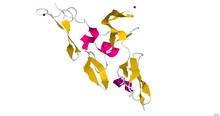Protein family
Not to be confused with
Fibrin.
Fibrillin is a glycoprotein, which is essential for the formation of elastic fibers found in connective tissue.[2]
Fibrillin is secreted into the extracellular matrix by fibroblasts and becomes incorporated into the insoluble microfibrils, which appear to provide a scaffold
for deposition of elastin.[3]
- ^ PDB: 2W86; Jensen SA, Iqbal S, Lowe ED, Redfield C, Handford PA (May 2009). "Structure and interdomain interactions of a hybrid domain: a disulphide-rich module of the fibrillin/LTBP superfamily of matrix proteins". Structure. 17 (5): 759–68. doi:10.1016/j.str.2009.03.014. PMC 2724076. PMID 19446531.
- ^ Kielty CM, Baldock C, Lee D, Rock MJ, Ashworth JL, Shuttleworth CA (February 2002). "Fibrillin: from microfibril assembly to biomechanical function". Philosophical Transactions of the Royal Society of London. Series B, Biological Sciences. 357 (1418): 207–17. doi:10.1098/rstb.2001.1029. PMC 1692929. PMID 11911778.
- ^ Singh (2006). Textbook of human histology. Jaypee Brothers Publishers. pp. 64–. ISBN 978-81-8061-809-3. Retrieved 9 December 2010.[permanent dead link]
